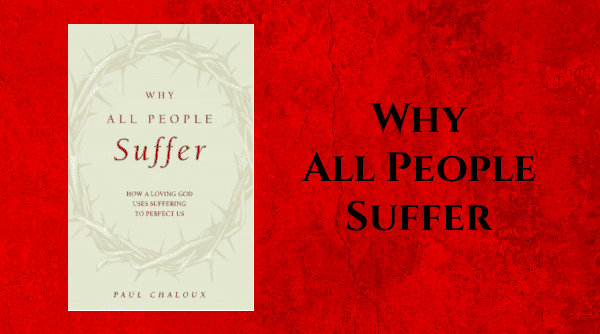Why is there suffering in the world? It’s a question asked by every human being at some point in their lives, usually when it directly affects themselves or a loved one. Many find it difficult to reconcile how a good, all-powerful God could allow people to suffer, particularly in the case of innocent children, and they lose faith. It was for people like this that Why All People Suffer was written.
Drawing from scripture, the Catechism of the Catholic Church, St. John Paul II, St. Thomas Aquinas and scores of others, both inside and external to the Catholic Church, Why All People Suffer makes the case that suffering is not the act of a vengeful God, but is a gift of a loving God that allows us to sense the evil that threatens us. Because suffering is persistent and uncomfortable, it motivates us to avoid evil and instead, seek out the good we lack. For instance, when we are hungry, we are motivated to eat and when we are lonely, we are motivated to seek out companionship.
Suffering is an intrinsic part of God’s plan for mankind and it has four tasks to lead men from sin to salvation. The first task is to teach us proper self-love, using simple feedback loops to build human virtue like if we eat too much, we get sick and if we treat people unfairly, they complain. This task is common to all humans everywhere and does not require even an acknowledgment of God to work effectively. The second task is to instill a love of god by re-orienting us to His will. This occurs either through the build-up of virtue from the first task leading to the greatest good, which is God or through suffering so severe that only God can help. The third task is to unleash our love of neighbor by making us empathetic when in the presence of suffering. The fourth task is to teach us how to love as Jesus did, willing to suffer for the benefit of another as part of God’s plan for salvation.
The second section of Why All People Suffer addresses the role of evil in God’s plan, explaining how God uses all types of evil to bring about the salvation of men. This is made understandable because as discussed in the first chapter of the first book of the Bible, everything that God made is good for its intended purpose. Evil, therefore, exists only as the absence or loss of goodness, just as darkness is the absence of light. It is not only not in opposition to good but represents an opportunity for perfection from a God who can make anything from nothing. In this section, the four types of evil (sin, punishment, natural and physical evils) are discussed and examples are given of how they are used by God in conjunction with suffering to bring about salvation. This includes examples of childhood disabilities, wars, natural disasters, and pandemics that many find so vexing.
The final section recognizes suffering as a calling from God and explains how to effectively heed one’s suffering to lead to joy. In this, the application section of the book, advice is given on how to live joyfully with chronic disease and how to die well for the terminally ill. It explains that those who suffer are messengers of God, capable of sharing the lessons of their condition to help others avoid it or live better with it. It discusses the role of the church for the sufferer and also explores how to most effectively care for those who suffer and ends with the joy in finding meaning in suffering.
Editor’s note: For more on Why All People Suffer, see Jordan Burke’s Webinar with Paul Chaloux here and the live recording of a Divine Intimacy Radio episode featuring the book with Dan and Stephanie Burke here.




